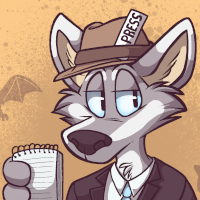The Goat: Building the Perfect Victim, by Bill Kieffer – book review by Fred Patten.
by Patch O'Furr
Submitted by Fred Patten, Furry’s favorite historian and reviewer.
 The Goat: Building the Perfect Victim, by Bill Kieffer
The Goat: Building the Perfect Victim, by Bill Kieffer
Manvel, TX, Red Ferret Press, September 2016, trade paperback $13.95 (158 [+ 1] pages), Kindle $3.99.
This book boasts – or warns – in a back-cover blurb that it delves into “the darkest, deepest reaches of human nature.” It isn’t pretty.
Frank, the narrator, seems like a total loser. He’s sullen, gloomy, depressed, works at a junk yard, and is in an abusive marital relationship. He keeps walking out on his domineering wife Kim, getting into a good relationship with some other woman, then Kim finds him, throws out the other woman, and starts her game of psychological dominance again.
He’s escaped from Kim again (only temporarily, he’s sure), gotten drunk at Phil’s Liquor Locker, and is walking back to his junker car when he sees a gang of wolfboys shoving around a gay man.
“Oh, they weren’t real wolves, but try to tell them that. The six or seven of them were trans-anthropomorphic teenagers from that private wizard school, Matthias.” (p. 18)


 ConFurence, the
ConFurence, the 
 The King of Las Vegas, by John Van Stry
The King of Las Vegas, by John Van Stry Swift the Cat-Human, by Angelo Bowles. Illustrated by Charlene Bowles.
Swift the Cat-Human, by Angelo Bowles. Illustrated by Charlene Bowles. Fred Patten’s Five Fortunes (FurPlanet, 2014, $19.95) is a collection of five novellas from some of the best writers in the G-rated Furry Fandom.
Fred Patten’s Five Fortunes (FurPlanet, 2014, $19.95) is a collection of five novellas from some of the best writers in the G-rated Furry Fandom. The Relics of Thiala, by Beryll & Osiris Brackhaus.
The Relics of Thiala, by Beryll & Osiris Brackhaus. Beast of War, by Mina S. Kitsune. Illustrated by Sal Hernandez.
Beast of War, by Mina S. Kitsune. Illustrated by Sal Hernandez. The Guardian Herd: Windborn, by Jennifer Lynn Alvarez. Illustrated by David McClellan; maps.
The Guardian Herd: Windborn, by Jennifer Lynn Alvarez. Illustrated by David McClellan; maps.